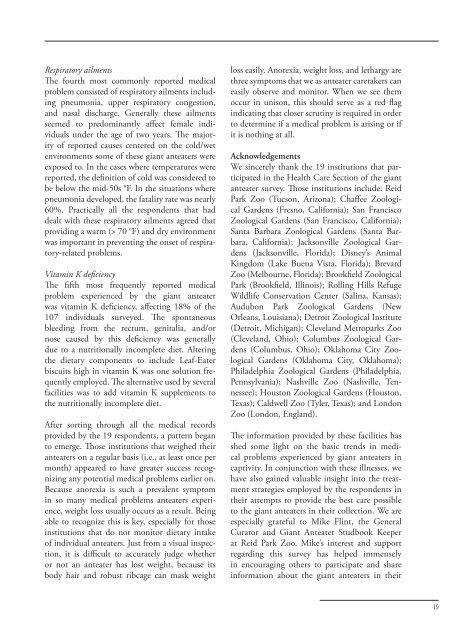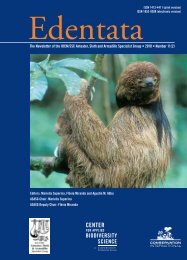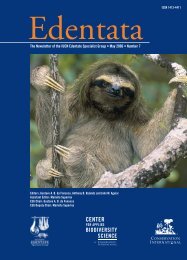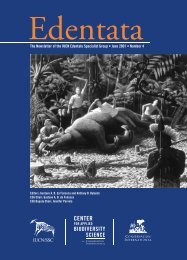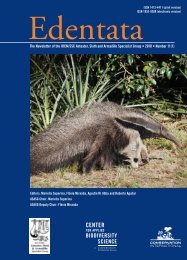Edentata 5 - Anteater, Sloth & Armadillo Specialist Group
Edentata 5 - Anteater, Sloth & Armadillo Specialist Group
Edentata 5 - Anteater, Sloth & Armadillo Specialist Group
Create successful ePaper yourself
Turn your PDF publications into a flip-book with our unique Google optimized e-Paper software.
Respiratory ailmentse fourth most commonly reported medicalproblem consisted of respiratory ailments includingpneumonia, upper respiratory congestion,and nasal discharge. Generally these ailmentsseemed to predominantly affect female individualsunder the age of two years. e majorityof reported causes centered on the cold/wetenvironments some of these giant anteaters wereexposed to. In the cases where temperatures werereported, the definition of cold was considered tobe below the mid-50s °F. In the situations wherepneumonia developed, the fatality rate was nearly60%. Practically all the respondents that haddealt with these respiratory ailments agreed thatproviding a warm (> 70 °F) and dry environmentwas important in preventing the onset of respiratory-relatedproblems.Vitamin K deficiencye fifth most frequently reported medicalproblem experienced by the giant anteaterwas vitamin K deficiency, affecting 18% of the107 individuals surveyed. e spontaneousbleeding from the rectum, genitalia, and/ornose caused by this deficiency was generallydue to a nutritionally incomplete diet. Alteringthe dietary components to include Leaf-Eaterbiscuits high in vitamin K was one solution frequentlyemployed. e alternative used by severalfacilities was to add vitamin K supplements tothe nutritionally incomplete diet.After sorting through all the medical recordsprovided by the 19 respondents, a pattern beganto emerge. ose institutions that weighed theiranteaters on a regular basis (i.e., at least once permonth) appeared to have greater success recognizingany potential medical problems earlier on.Because anorexia is such a prevalent symptomin so many medical problems anteaters experience,weight loss usually occurs as a result. Beingable to recognize this is key, especially for thoseinstitutions that do not monitor dietary intakeof individual anteaters. Just from a visual inspection,it is difficult to accurately judge whetheror not an anteater has lost weight, because itsbody hair and robust ribcage can mask weightloss easily. Anorexia, weight loss, and lethargy arethree symptoms that we as anteater caretakers caneasily observe and monitor. When we see themoccur in unison, this should serve as a red flagindicating that closer scrutiny is required in orderto determine if a medical problem is arising or ifit is nothing at all.AcknowledgementsWe sincerely thank the 19 institutions that participatedin the Health Care Section of the giantanteater survey. ose institutions include: ReidPark Zoo (Tucson, Arizona); Chaffee ZoologicalGardens (Fresno, California); San FranciscoZoological Gardens (San Francisco, California);Santa Barbara Zoological Gardens (Santa Barbara,California); Jacksonville Zoological Gardens(Jacksonville, Florida); Disney’s AnimalKingdom (Lake Buena Vista, Florida); BrevardZoo (Melbourne, Florida); Brookfield ZoologicalPark (Brookfield, Illinois); Rolling Hills RefugeWildlife Conservation Center (Salina, Kansas);Audubon Park Zoological Gardens (NewOrleans, Louisiana); Detroit Zoological Institute(Detroit, Michigan); Cleveland Metroparks Zoo(Cleveland, Ohio); Columbus Zoological Gardens(Columbus, Ohio); Oklahoma City ZoologicalGardens (Oklahoma City, Oklahoma);Philadelphia Zoological Gardens (Philadelphia,Pennsylvania); Nashville Zoo (Nashville, Tennessee);Houston Zoological Gardens (Houston,Texas); Caldwell Zoo (Tyler, Texas); and LondonZoo (London, England).e information provided by these facilities hasshed some light on the basic trends in medicalproblems experienced by giant anteaters incaptivity. In conjunction with these illnesses, wehave also gained valuable insight into the treatmentstrategies employed by the respondents intheir attempts to provide the best care possibleto the giant anteaters in their collection. We areespecially grateful to Mike Flint, the GeneralCurator and Giant <strong>Anteater</strong> Studbook Keeperat Reid Park Zoo. Mike’s interest and supportregarding this survey has helped immenselyin encouraging others to participate and shareinformation about the giant anteaters in their19


